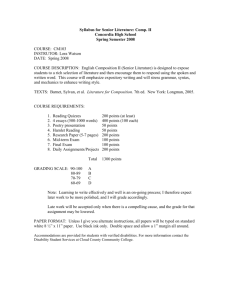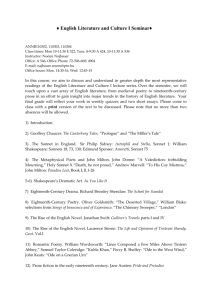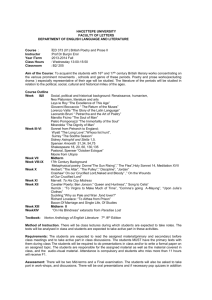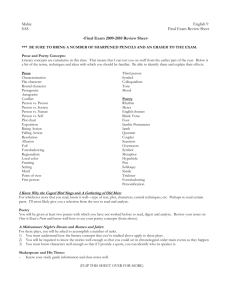Dec 5 - phamENG12
advertisement
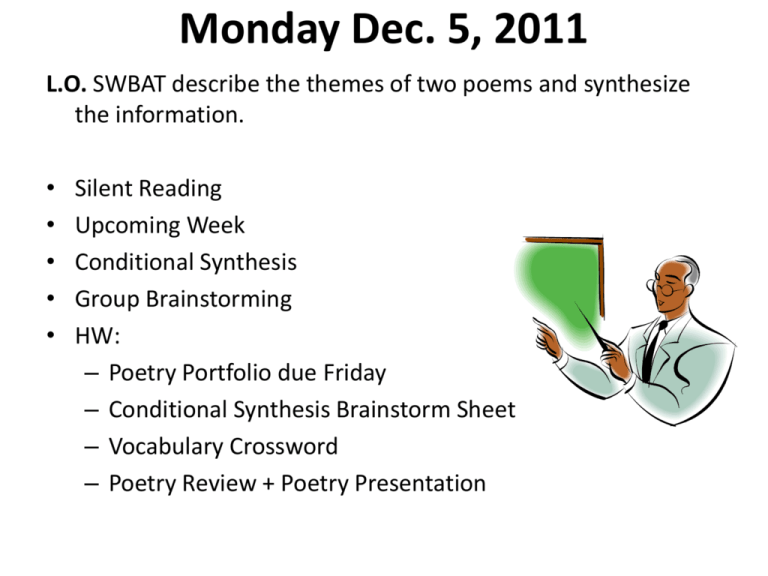
Monday Dec. 5, 2011 L.O. SWBAT describe the themes of two poems and synthesize the information. • • • • • Silent Reading Upcoming Week Conditional Synthesis Group Brainstorming HW: – Poetry Portfolio due Friday – Conditional Synthesis Brainstorm Sheet – Vocabulary Crossword – Poetry Review + Poetry Presentation This Week • • • • • • • Dec. 6 Tuesday – Hand in Vocab Crossword Dec. 7 Wednesday – Work Period Dec. 8 Thursday – Poetry Review – Work Period? Dec. 9 Friday – Poetry Portfolio Due/Poetry Test Dec. 12 Monday – Poetry Presentations Dec. 13 Tuesday – Poetry Presentations Dec. 14 Wednesday – Creative Writing Intro + Conditional Synthesis Paragraph • Dec. 16 – Grade 10 Vocab Matching Test Dylan Thomas– Do Not Go Gentle Into That Good Night • • • • Welsh Poet (1914-1953) Written for his dying father One of his most popular poems Doctor gave him four years to live Do Not Go Gentle Into That Good Night Explanation #1 • Watched his father, formerly in the Army, grow weak and frail with old age • Speaker tries to convince his father to fight against imminent death • Uses “wise, good, wild, grave” men – illustrate the same message that no matter how they have lived or what they feel at the end, they should die fighting • One should not die without fighting for one’s life or after life Do Not Go Gentle Into That Good Night Explanation #2 • Speaker admits that death is unavoidable, but encourages all men to fight death • This is not for them, but to give closure and hope for their loved ones left behind • “Curse, bless me now with your fierce tears, I pray” • Never showed this poem to his father, so he composed it more for his own benefit Do Not Go Gentle Into That Good Night Explanation #X • The author’s own fear of death • Fear having little separation between life and death • Father’s own catharsis before passing on • Wild hope that he will see his father before he passes Do Not Go Gentle Into That Good Night • Structured as a villanelle – Only has two rhyme sounds – The first and third lines of the first stanza are rhyming refrains that alternate as the third line in each successive stanza and form a couplet at the close – 19 lines long, consisting of five tercets (3 lines forming a stanza) and one concluding quatrains Do Not Go Gentle Into That Good Night • Villanelles usually imply a light gay tone • Profound paradox: unavoidable death in the face of the perpetual rhythm of rebirth • The refrains – courage and frustration, strength and grieving • The different epithets (word or phrase applied to a person or thing to describe an actual or attributed quality) “wise”, “good”, “wild”, and “grave” – attitudes of men in front of their last challenge John Donne – Holy Sonnet X: Death, Be Not Proud • Sonnet # 10 • A metaphysical poem • Written around 1610 and pushing posthumously in 1633 John Donne – Holy Sonnet X: Death, Be Not Proud • Sonnet addresses Death, telling him not to be proud, because death is not to be feared • Sleep is a type of death, and that is pleasurable; then death must be even more so • Death is a slave to fate, chance (accidental death), kings (who have the power of life and death), and desperate men • ABBA ABBA CDDC AE rhyme scheme John Donne – Holy Sonnet X: Death, Be Not Proud • Lines 1 – 2 – Addressing Death as an equal, apparent later as inferior – Death likes to think of himself as powerful and terrifying – Some people have called him that, but that is not truth John Donne – Holy Sonnet X: Death, Be Not Proud • Lines 3-4 – Death thinks that he is “overthrowing” men when he takes them (i.e. conquering, vanquishing, ruining, etc.) – Death is a means by which man finds Resurrection, eternal life and immortality through Christ in heaven – “poor Death” – sarcastic, patronizing – “nor yet canst thou kill me” – Death does not kill, but is the enabler of new, immortal life – Cannot kill, so holds no power over the speaker John Donne – Holy Sonnet X: Death, Be Not Proud • Lines 5 - 8 – Idea of sleep as death’s image – (Parallel of sleeping/waking and dying/waking is noted later in the sonnet) – Best man of the era go unhesitatingly to their deaths – They wisely realized death is another form of sleep – Their bones go to their rest (graves) and their soul gets “delivered” (set free) – Multiple meanings: being freed from the human body, freed from the fear of death, delivered into heaven, delivered in the sense of being born John Donne – Holy Sonnet X: Death, Be Not Proud • Lines 9-10 – Death is a slave – Fate, chance, kings, and desperate men as his “master” – Personified Death does not always have the power to choose who is to die – Fate and chance may suddenly take someone – Kings on a whim may doom people to their deaths – Desperate men, who see no way out, may take their own lives – Cheats Death of his control and mastery – Likens Death to a scavenger who cleans up where poison, war, and sickness have raged – How proud is his position now? John Donne – Holy Sonnet X: Death, Be Not Proud • Lines 11-12 – Back to sleep/Death image – Drugs alike have the power of producing sleep, and in fact, create a truer sleep than Death (since Death is a fleeting moment’s sleep before resurrection) – Death’s self-image is belittled and shown as false – Question: What reason have you, Death, to be proud? (Image is that of a chest swelling with pride) John Donne – Holy Sonnet X: Death, Be Not Proud • Lines 13 – 14 – “One short sleep past” – fleeting moment – “We wake eternally” – we will wake up resurrected, to eternal life, never to sleep or die again – “Death, thou shalt die” Then, death will cease to exist altogether, will die – Death is a mere mortal, or rather less than mortals – Idea that Death is the one who should be afraid, not the one to be feared HOMEWORK • Vocab Crossword • Thesis + 3 Supporting Points • Read Poetry Cafe Poetry Review 1. Poetic Devices – See Poetic Device Sheet – See ENG 12 Literary Terms Sheet 2. Poetic Forms Assignment (Forms + Types) – Be able to read a poem and label them – E.g. Narratives, Didactic, Lyric, Etc. 3. Synthesis Hook + Synthesis Structure – You will be writing a Synthesis Essay Tuesday Dec. 6, 2011 L.O. SWBAT present a thesis and understand synthesis structure. • • • • • Silent Reading + Collect Vocab Synthesis Discussion Group Discussion on Poems Present Brainstorm to Class HW: – Poetry Portfolio due Friday – Conditional Synthesis Brainstorm Sheet – Poetry Review (Test Friday) + Poetry Presentation Wednesday Dec. 7, 2011 L.O. SWBAT… • Work Period • HW: – Poetry Portfolio due Friday – Conditional Synthesis Brainstorm Sheet – Poetry Review: Test Friday – Poetry Presentation (Dec. 12/13) Thursday Dec. 8, 2011 L.O. SWBAT demonstrate their understanding of the main concepts in poetry. • Review Period • HW: – Poetry Portfolio due tomorrow – Poetry Test tomorrow – Poetry Presentation (Dec. 12/13) Friday Dec. 9, 2011 L.O. SWBAT demonstrate their understanding of the main concepts in poetry. • Poetry Test • HW: – Poetry Presentation (Dec. 12/13) – Conditional Synthesis Package – Grade 10 Vocab Dec. 16
